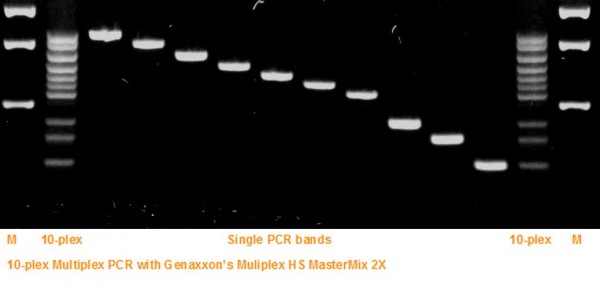Multiplex qPCR MasterMix (2x) - lyophilisiert
Artikel-Nr.: M3005.0100
Shipping: Shipment: not cooled. Store at +15°C to +30°C. For laboratory usage only! Lieferzeit: 3 - 8 Werktage
Für genaue Informationen zum Liefertermin wenden Sie sich bitte an Genaxxon.
*Preise zzgl. gesetzlicher MwSt. zzgl. Versandkosten
Infos Lieferbedingungen & Versandkosten >>
Multiplex qPCR MasterMix (2x) für die schnelle und zuverlässige Quantifizierung von bis zu 5 cDNA 4 cDNA oder gDNA Targets in einem einzigen PCR-Tube durch Multiplex realtime PCR. Der speziell optimierte und lyophilisierte Mastermix fördert die Multiplex realtime PCR. Die Kombination des speziell entwickelten Hotstart und PCR-Puffersystems in lyophilisierter Form garantiert hohe Sensitivität und bietet gleichzeitig die Möglichkeit den Mastermix auch ungekühlt bei Raumtemperatur gelagert stabil zu halten.
Unser neuer lyophilisierter Multiplex Mastermix für das schnelle und einfache multiplexen minimiert den Aufwand für die Optimierung und macht die Entwicklung von Multiplex PCR Assays einfach und schnell.
- Amplifikation von unterschiedlichen Targets in einem einzigen PCR-Tube (für bis zu 5 Targets getestet).
- All-in-one Mastermix für das leichte multiplexen.
- Hohe Spezifität, Sensitivität und Produktausbeute.
- Einfaches Set-up bei Raumtemperatur.
- lyophilisiert: stabil bei Raumtempertur
Der Genaxxon Multiplex PCR Mastermix ist eine fertige ("ready-to-use") lyophilisierte Mischung aus unserer hochspezifischen Hotstart Taq DNA-Polymerase, hochreinen dNTPs, MgCl2, Additiven und einem Puffer mit optimalem Konzentrationsverhältnis, um eine zuverlässige Multiplex PCR, wie z.B. eine Mikrosatelliten-, Klonalitäts- oder Genrearrangementanalyse durchzuführen. Nur noch Primer und Template-DNA müssen dazu gegeben und das PCR-Protokoll kann gestartet werden.
Der lyophilisierte Multiplex qPCR MasterMix wird in Aliquots verschickt, die 250µL 2-fach Mastermix entsprechen.
Weitere Realtime PCR Mastermixe passend für Ihre PCR finden Sie >hier.
Beispiele für Multiplexandwendungen:
F. Javier Pérez-Pérez and Nancy D. Hanson, Detection of Plasmid-Mediated AmpC β-Lactamase Genes in Clinical Isolates by Using Multiplex PCR, J. Clin. Microbiol. June 2002 vol. 40 no. 6 2153-2162. doi: 10.1128/JCM.40.6.2153-2162.2002.
The Multiplex master mix for fast and easy multiplexing minimizes the need for optimization and makes the development of multiplex PCR assays fast and easy. - Amplification of multiple targets in a single tube (tested for up to 5 targets) - All-in-one master mix for convenient multiplexing - High specificity, sensitivity and product yield - Easy reaction setup at room temperature - stable at room temperature
Technische Daten:
Specifications:
2-time ready-to-use lyophilised Multiplex master mix with an optimized modified Taq DNA polymerase without green fluorescent dye and without ROX™.
Aliquot size: 250µL.
The lyophilized realtime PCR master mix is stable for at least 24 months at room temperature.
Applikation:
Multiplex PCR for Microsatellite analysis clonality analysis gene rearrangement analysisEinheitendefinition:
One unit is defined as the amount of enzyme which will convert 10 nmoles of dNTPs to an acid-insoluble form in 30 min at 72°C under the assay conditions (25 mM TAPS (tris-(hydroxymethyl)-methyl-amino-propanesulfonic acid, sodium salt) pH 9.3 (25°C); 50 mM KCl; 2 mM MgCl2; 1 mM b-mercaptoethanol; and activated calf thymus DNA as substrate.Quelle
syntheticSicherheits Hinweise / Safety
Klassifizierungen / Classification
eclass-Nr: 32-16-05-02Dokumente - Protokolle - Downloads
Hier finden Sie Informationen und weiterführende Literatur zu Multiplex qPCR MasterMix (2x) - lyophilisiert. Für weitere Dokumente (Zertifikate mit weiteren Lotnummern, Sicherheitsdatenblätter in anderer Sprache, weitere Produktinformationen) wenden Sie sich bitte an Genaxxon biosience unter: info@genaxxon.com oder Tel.: +49 731 3608 123.


















